Focus: The Air Force Reserve's contribution to the security of the United States and the world fulfils visions begun one hundred years ago when, in 1907, the Aeronautical Division in the Signal Corps became responsible for military "air machines," and some sixty years ago when President Harry Truman directed in the National Security Act of 1947 that the services revitalize their reserve programs. Since its inception in April 1948, the Air Force Reserve has evolved from a mobilization-only force into an operational reserve integrated 24/7 with the active Air Force. Dedicated Citizen Airmen stand ready -- to provide combat-ready forces to fly, fight and win ... airpower anytime, anywhere!
1948 - 1968: The historical origins of an air reserve in the US military stem from the Preparedness Movement and the National Defense Act of 1916 that authorized an Organized Reserve Corps. The Air Force Reserve was formally established on April 14, 1948 by President Harry Truman who envisioned a program similar to one established during the First World War, whereby Reservists stood ready to serve during wartime.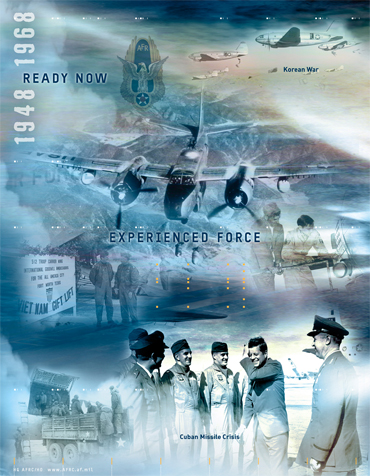
When the Korean War erupted in 1950, the Air Force Reserve consisted of over 315,800 non-drilling and nearly 58,500 drilling Reservists in combat sustaining units, namely 20 troop carrier wings outfitted with C-46s and C-47s (later C-119s), and five light bombardment wings of B-26s. Between July 1950 and June 1953, the Air Force mobilized nearly 147,000 Air Force Reservists to active service for periods from one to three years. Five Air Force Reserve units remained on active service while another 15 units were called up to replace and fill out active units. Air Force Reservists performed well, as demonstrated by unit citations and the recalled individuals who became fighter aces.
During the 1950s, several legislative acts addressed concerns with the national reserve program, establishing the Ready, Standby, and Retired Reserve categories. Units were provided with full-time air reserve technician (ART) trainers and the President was authorized to mobilize a portion of the Ready Reserve to active duty without advanced congressional notification.
In the 1960s the services relied on the Reserve forces to support the Berlin and Cuban Crises. While still transitioning to new aircraft, five Air Force Reserve C-124 units along with 5,613 Reservists were mobilized for a year during the Berlin Crisis. When the Cuban Crisis intensified, Reserve aircrews flew C-119s and materiel to Key West Naval Air Station and Homestead AFB, Florida. Mobilizations followed with 14,220 Air Force Reservists and 422 aircraft on active duty by 28 October 1962.
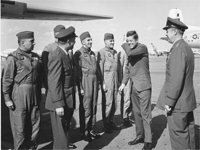 The Air Force again called on the Air Force Reserve to participate in the Vietnam War effort. Reservists voluntarily provided direct and indirect support with few mobilizations. Needing more strategic airlift into the Vietnam Theater, the Air Force Reserve responded by flying C-124 missions as part of their inactive duty, annual two-week training, and an additional 36 days of inactive duty days until US involvement ended in 1973. Air Force Reserve rescue and recovery, intelligence and medical specialists, aerial porters, maintainers, lawyers, and chaplains comprised the range of support provided. Desiring more augmentation from the Air Force Reserve and yet unable to procure enough new C-141s, the Air Force initiated in 1968 the associate concept whereby Air Force Reserve personnel would associate with an active duty unit equipped with new C-141s or C-9s, flying and performing maintenance together.
The Air Force again called on the Air Force Reserve to participate in the Vietnam War effort. Reservists voluntarily provided direct and indirect support with few mobilizations. Needing more strategic airlift into the Vietnam Theater, the Air Force Reserve responded by flying C-124 missions as part of their inactive duty, annual two-week training, and an additional 36 days of inactive duty days until US involvement ended in 1973. Air Force Reserve rescue and recovery, intelligence and medical specialists, aerial porters, maintainers, lawyers, and chaplains comprised the range of support provided. Desiring more augmentation from the Air Force Reserve and yet unable to procure enough new C-141s, the Air Force initiated in 1968 the associate concept whereby Air Force Reserve personnel would associate with an active duty unit equipped with new C-141s or C-9s, flying and performing maintenance together.
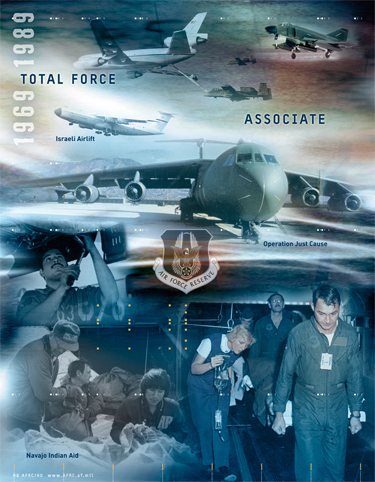 1969 - 1989: As the 1970s unfolded, the challenge then was to find the right mix of forces for mission effectiveness. Secretary of Defense Melvin Laird adopted the Total Force concept in August 1970 with Secretary of Defense James Schlesinger declaring it policy in 1973.
1969 - 1989: As the 1970s unfolded, the challenge then was to find the right mix of forces for mission effectiveness. Secretary of Defense Melvin Laird adopted the Total Force concept in August 1970 with Secretary of Defense James Schlesinger declaring it policy in 1973.
With the implementation of the Total Force Policy, the Air Force Reserve became a multi-mission force, flying the same modern aircraft as the active Air Force. Mobilization planning and operational evaluation were integrated with the corresponding active duty functions. With the same equipment and budget authority, the Air Force Reserve was held to the same readiness standards and inspections as regular Air Force units. Special operations, air refueling, weather reconnaissance, and, once again, fighter missions were added to the airlift, rescue, and mission support roles performed by the Air Force Reserve. The associate concept soon expanded to include the C-5.
Air Force Reserve participation in Air Force exercises and deployments perfected its mobility capabilities as demonstrated throughout the seventies, most notably during the Israeli Airlift of 1973, some 630 crewmembers volunteered for Middle East missions to include flying into Tel Aviv while another 1,590 Reservists performed missions worldwide, freeing up more active crews for airlift.
The 1980s saw the modernization and expansion of the Air Force Reserve program. KC-10s joined the associate force in 1981. Fighter units obtained the more modern A-10s and F-4s, and in 1984, the Air Force Reserve received its first F-16. Operationally, the Air Force Reserve returned American students from Grenada in 1983, performed air refuelings of F-111 bombers during the El Dorado Canyon raid on Libyan-sponsored terrorists in 1986, and acted as a full partner in Operation Just Cause which ousted Panama's General Noriega in 1989-1990. Air Force Reservists also supported humanitarian and disaster relief efforts, including resupply and evacuation missions in the aftermath of Hurricane Hugo. The Reserve's continual volunteering allayed the concerns of those who believed the Air Force Reserve would not be available when really needed.
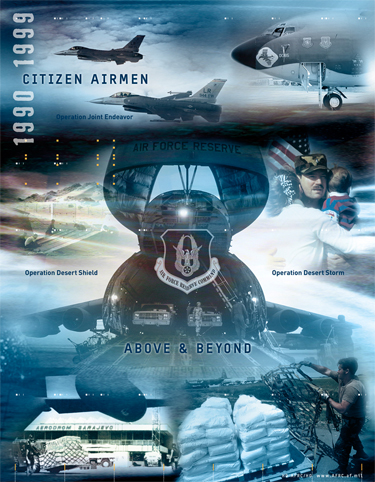 1990 - 1999: Air Force Reserve airlift and tanker crews were flying within days of Saddam Hussein's invasion of Kuwait in 1990.
1990 - 1999: Air Force Reserve airlift and tanker crews were flying within days of Saddam Hussein's invasion of Kuwait in 1990.
When ground operations commenced, Air Force Reserve A-10s operated close to the front lines along with Air Force Reserve special operations and rescue forces.
A Reservist scored the first-ever A-10 air-to-air kill. When Operations Desert Shield/Storm ended, the air Force Reserve counted 23,500 Reservists mobilized with another 15,000 serving in a volunteer capacity.
The Air Force Reserve had become indistinguishable from the active force in capability; there was no difference between an Air Force Reserve pilot and an active duty pilot, or a boom operator, or loadmaster.
In the aftermath of Desert Storm, Air Force Reservists continued to serve and were heavily involved in enforcing the no-fly zone over northern and southern Iraq as well as in humanitarian relief missions to assist uprooted Iraqi Kurds. For over six years, Air Force Reserve C-130s performed these Provide Comfort missions on a rotational basis while F-16s and rescue HH-60s deployed to Incirlik Air Base, Turkey, for the no-fly operations. In 1993, when tensions mounted in Bosnia, Air Force Reserve tanker and fighter units participated in enforcing the Deny Flight no-fly zone while airlift units ensured logistical resupply.
The Air Force increasingly relied on its Air Force Reserve component for a "steady state" of daily assistance--whether it was flying airlift channel, fire fighting, aerial spray, hurricane hunter missions, or providing highly skilled medical and aeromedical personnel. As a result, Congress sought to clarify the organizational placement of the reserves. Accordingly, in February 1997, the Air Force Reserve officially became the Air Force Reserve Command, the Air Force's ninth major command.
Between March and September 1999, Air Force Reservists volunteered and were also mobilized for Allied Force operations over Serbia and Kosovo. The involuntary recall marked the ninth time the Air Force had requested a mobilization of Air Force Reserve units and personnel since 1950. In summary, Reservists provided 150,000 mandays of support that spanned the spectrum of our missions. The Air Force Reserve once again proved itself as an adaptable and capable force, ready to perform the full range of Air Force operations on an integrated and daily basis in sync with the new Air and Space Expeditionary Force (AEF) concepts.
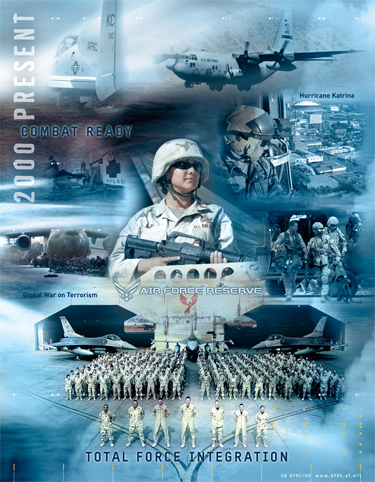 2000 - Present: When terrorists attacked the United States on September 11, 2001, Air Force Reservists responded in full measure. Air Force Reserve F-16 fighters flew combat air patrols (CAPs) protecting America's cities while KC-135 tanker and AWACs aircraft supported with air refuelings and security. In October 2001, the United States initiated the Global War On Terrorism as military forces entered Afghanistan to combat the Taliban in Operation Enduring Freedom. Air Force Reserve MC-130 Combat Talon aircraft became the first fixed-wing aircraft to penetrate Afghan airspace while Air Force Reserve F-16 crews, already deployed in theater for Operation Southern Watch, performed the first combat missions.
2000 - Present: When terrorists attacked the United States on September 11, 2001, Air Force Reservists responded in full measure. Air Force Reserve F-16 fighters flew combat air patrols (CAPs) protecting America's cities while KC-135 tanker and AWACs aircraft supported with air refuelings and security. In October 2001, the United States initiated the Global War On Terrorism as military forces entered Afghanistan to combat the Taliban in Operation Enduring Freedom. Air Force Reserve MC-130 Combat Talon aircraft became the first fixed-wing aircraft to penetrate Afghan airspace while Air Force Reserve F-16 crews, already deployed in theater for Operation Southern Watch, performed the first combat missions.
Air Force Reservists made significant contributions by flying close air support, combat delivery, rescue, strategic airlift, and air refueling missions supporting operations in Afghanistan. They also provided B-52, special operations, aeromedical, security forces, and civil engineering support. Air Force Reserve A-10s, HH-60s and C-130s still continue to perform rotational tours in Afghanistan, and Air Force Reservists have been instrumental in building the Afghan National Army Air Corps. When war against Saddam Hussein's regime began in March 2003, Air Force Reserve combat-ready A-10, B-52, and F-16 aircrews flew numerous strike operations during the first hours of engagement and performed special operations and rescue missions. Air Reserve rescue personnel were among the first into Tallil Air Base as Reserve A-10s provided close air support. Part of the lead tanker force, Reserve tankers offloaded more than 21 million pounds of fuel to more than 1,000 aircraft. In late March 2003, fifteen C-17 Reserve associate crews supported the C-17 airdrop, which opened up the Northern Front in Iraq.
Additionally, Reservists supported Air Force unmanned aerial vehicles (UAV) missions and space-based operations in Southwest Asia, providing essential data to battlefield commanders. During the combat phase (19 March-1 May) Air Force Reserve aircraft and crews flew nearly 162,000 hours and deployed 70 unit-equipped aircraft in theater while aeromedical personnel provided 45 percent of the Air Force's aeromedical crews that performed 3,108 patient movements.
The Air Force Reserve continues to expand its associate construct across the mission spectrum. Specific examples are the Air Force Reserve associating at Elmendorf AFB, Alaska, flying the F-22 and the active duty associating with the C-40C at Scott AFB, and the C-5 at Lackland AFB, Texas. On the horizon, associate units will include future weapon systems such as the F-35 Lightning II and the Next Generation Bomber.
In adapting, changing, and responding these past sixty years, the Air Force Reserve has truly evolved into an operational reserve force. Dedicated Citizen-Reservists provide the world's best mutual support to the Air Force and our joint partners--to provide combat-ready forces to fly, fight and win.